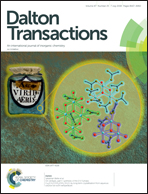1D hetero-bimetallic regularly alternated 4f–3d coordination polymers based on N-oxide-4,4′-bipyridine (bipyMO) as a linker: photoluminescence and magnetic properties†
Abstract
Heterotopic divergent ligand N-oxide-4,4′-bipyridine (bipyMO) has been herein exploited for the preparation of hetero-bimetallic coordination polymers where Ln(hfac)3 and M(hfac)2 nodes regularly alternate (Hhfac = 1,1,1,5,5,5-hexafluoro-2,4-pentanedione), bipyMO being able to selectively use its two potential coordination sites to discriminate the metal ions. The synthesis of three coordination polymers, [Ln(hfac)3M(hfac)2(bipyMO)2]n (Ln = Eu, M = Zn, 1; Ln = Eu, M = Cu, 2, Ln = Dy, M = Co, 3), was carried out by reacting the appropriate [M(hfac)2(bipyMO)]n and [Ln(hfac)3] precursors in toluene in the presence of a given stoichiometric amount of bipyMO. The products were characterized by elemental analysis, X-ray powder diffraction, and FTIR spectroscopy. Single crystal X-ray diffraction studies carried out on 2 showed that it was formed by chains containing the hexa-coordinated 3d metal (Cu(hfac)2[N]2) and the octa-coordinated lanthanide (Eu(hfac)3[O]2) nodes, where [N] and [O] stand for the donor atom of the bridging divergent ligand. The X-ray powder diffraction patterns of the three compounds and the comparison of their cell constant values allowed establishing that the derivatives were isotypic. Photoluminescence (PL) studies on microcrystalline sample powders evidenced a bright red emission for 1 with an absolute PL quantum yield of 0.24. The sensitized emission of Eu3+ can be excited in a wide wavelength range, from UV to visible, up to ≈450 nm. Conversely, europium emissions are not detectable in 2 due to the presence of Cu(hfac)2(bipyMO) moieties whose strong absorption overlaps Eu3+ transitions. Magnetic measurements conducted on 3 revealed the presence of a weak ferromagnetic interaction below 2.1 K. An ac susceptibility study highlighted a slow relaxation of the magnetization of 3 with an applied static magnetic field of 0.1 T, which could be equally fitted with a Orbach-direct or a Raman-direct mechanism. No relaxation dynamics was detected without the application of a static magnetic field.



 Please wait while we load your content...
Please wait while we load your content...